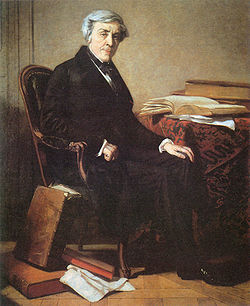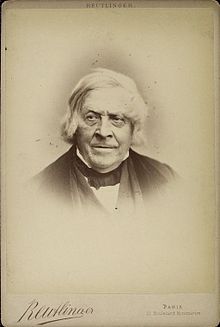- Jules Michelet
-
Jules Michelet (21 August 1798 – 9 February 1874) was a French historian. He was born in Paris to a family with Huguenot traditions.
Contents
Early life
His father was a master printer, not very prosperous, and Jules assisted him in the actual work of the press. A place was offered him in the imperial printing office, but his father was able to send him to the famous Collège or Lycée Charlemagne, where he distinguished himself. He passed the university examination in 1821, and was soon appointed to a professorship of history in the Collège Rollin.
Soon after this, in 1824, he married. This was one of the most favourable periods ever for scholars and men of letters in France, and Michelet had powerful patrons in Abel-François Villemain and Victor Cousin, among others. Although he was an ardent politician (having from his childhood embraced republicanism and a peculiar variety of romantic free-thought), he was above all a man of letters and an inquirer into the history of the past. His earliest works were school textbooks.
Between 1825 and 1827 he produced diverse sketches, chronological tables, etc., of modern history. His précis of the subject, published in 1827, is a sound and careful book, far better than anything that had appeared before it, and written in a sober yet interesting style. In the same year he was appointed maître de conferences at the École normale supérieure.
Four years later, in 1831, the Introduction à l'histoire universelle showed a very different style, exhibiting the idiosyncrasy and literary power of the writer to greater advantage, but also displaying, in the words of the Encyclopædia Britannica, Eleventh Edition, "the peculiar visionary qualities which made Michelet the most stimulating, but the most untrustworthy (not in facts, which he never consciously falsifies, but in suggestion) of all historians."
Record Office
The events of 1830 had placed him in a better position for study by obtaining him a place in the Record Office, and a deputy-professorship under Guizot in the literary faculty of the university. Soon afterwards he began his chief and monumental work, the Histoire de France that would take 30 years to complete. But he accompanied this with numerous other books, chiefly of erudition, such as the Œuvres choisies de Vico, the Mémoires de Luther écrits par lui-même, the Origines du droit français, and somewhat later the le Procès des Templiers.
1838 was a year of great importance in Michelet's life. He was in the fullness of his powers, his studies had fed his natural aversion to the principles of authority and ecclesiasticism, and at a moment when the revived activity of the Jesuits caused some real and more pretended alarm he was appointed to the chair of history at the Collège de France. Assisted by his friend Edgar Quinet, he began a violent polemic against the unpopular order and the principles which it represented, a polemic which made their lectures, and especially Michelet's, one of the most popular resorts of the day. He published, in 1839, his Histoire romaine, but this was in his graver and earlier manner. The results of his lectures appeared in the volumes Du prêtre, de la femme et de la famille and Le peuple. These books do not display the apocalyptic style which, partly borrowed from Lamennais, characterizes Michelet's later works, but they contain in miniature almost the whole of his curious ethicopolitico-theological creed—a mixture of sentimentalism, communism, and anti-sacerdotalism, supported by the most eccentric arguments, but urged with a great deal of eloquence.
The principles of the outbreak of 1848 were in the air, and Michelet was one of many who condensed and propagated them: his original lectures were of so incendiary a kind that the course had to be interdicted. However, when the revolution broke out, Michelet, unlike many other men of letters, did not attempt to enter active political life, and merely devoted himself more strenuously to his literary work. Besides continuing the great history, he undertook and carried out, during the years between the downfall of Louis Philippe and the final establishment of Napoleon III, an enthusiastic Histoire de la revolution française.
Minor books
The coup d'état lost Michelet his place in the Record Office, since he refused to take the oaths to the empire. The new régime kindled afresh his republican zeal, and his second marriage with Mlle Athenais Mialaret, a lady of some literary capacity and of republican sympathies, seems to have further stimulated his powers. While his great work of history was still his main pursuit, a crowd of extraordinary little books accompanied and diversified it. Sometimes they were expanded versions of its episodes, sometimes what may be called commentaries or companion volumes. In some of the best of them natural science, a new subject with Michelet, to which his wife is believed to have introduced him, supplies the text. The first of these (by no means the best) was Les Femmes de la revolution (1854), in which Michelet's natural and inimitable faculty of dithyrambic too often gives way to tedious and not very conclusive argument and preaching. In the next, L'Oiseau (1856), a new and most successful vein was struck. The subject of natural history was treated, not from the point of view of mere science, nor from that of sentiment, but from that of the author's fervent democratic pantheism.
L'Insecte, in the same key, but duller, followed. It was succeeded by L'Amour (1859), one of the author's most popular books. These remarkable works, half pamphlets half moral treatises, succeeded each other as a rule at the twelve months' interval, and the succession was almost unbroken for five or six years. L'Amour was followed by La Femme (1860), a book on which a whole critique of French literature and French character might be founded. Then came La Mer (1861), a return to the natural history class, which, considering the powers of the writer and the attraction of the subject, is perhaps a little disappointing. The next year (1862) the most striking of all Michelet's minor works, La Sorcière, made its appearance. Developed out of an episode of the history, it has all its author's peculiarities in the strongest degree. It is a nightmare and nothing more, but a nightmare of the most extraordinary verisimilitude and poetical power.
This remarkable series, every volume of which was a work at once of imagination and of research, was not even yet finished, but the later volumes exhibit a certain falling off. The ambitious Bible de l'humanité (1864), an historical sketch of religions, has but little merit. In La Montagne (1868), the last of the natural history series, the tricks of staccato style are pushed even farther than by Victor Hugo in his less inspired moments, though—as is inevitable, in the hands of such a master of language as Michelet—the effect is frequently grandiose if not grand. Nos fils (1869), the last of the string of smaller books published during the author's life, is a tractate on education, written with ample knowledge of the facts and with all Michelet's usual sweep, and range of view, if with visibly declining powers of expression. But in a book published posthumously, Le Banquet, these powers reappear at their fullest. The picture of the industrious and famishing populations of the Riviera is (whether true to fact or not) one of the best things that Michelet has done. To complete the list of his miscellaneous works, two collections of pieces, written and partly published at different times, may be mentioned. These are Les Soldats de la révolution and Legendes démocratiques du nord.
Michelet's Origines du droit français, cherchées dans les symboles et les formules du droit universel was edited by Émile Faguet in 1890 and went into a second edition in 1900.
The publication of this series of books, and the completion of his history, occupied Michelet during both decades of the empire. He lived partly in France, partly in Italy, and was accustomed to spend the winter on the Riviera, chiefly at Hyères.
Masterpiece
At last, in 1867, the great work of his life was finished. In the usual edition it fills nineteen volumes. The first of these deals with the early history up to the death of Charlemagne, the second with the flourishing time of feudal France, the third with the 13th century, the fourth, fifth, and sixth with the Hundred Years' War, the seventh and eighth with the establishment of the rural power under Charles VII and Louis XI. The 16th and 17th centuries have four volumes apiece, much of which is very distantly connected with French history proper, especially in the two volumes entitled Renaissance and Reforme. The last three volumes carry on the history of the 18th century to the outbreak of the Revolution.
Academic reception
Michelet was perhaps the first historian to devote himself to anything like a picturesque history of the Middle Ages, and his account is still the most vivid that exists. His inquiry into manuscript and printed authorities was most laborious, but his lively imagination, and his strong religious and political prejudices, made him regard all things from a singularly personal point of view. There is an unevenness of treatment of historical incidents. However, Michelet insistence that history should concentrate on “the people, and not only its leaders or its institutions” clearly drew inspiration from the French Revolution. Michelet was one of the first historians to apply these liberal principles to historical scholarship.
Political life
Uncompromisingly hostile as Michelet was to the empire, its downfall in 1870 in the midst of France's defeat by Prussia and the rise and fall of the Paris Commune during the following year once more stimulated him to activity. Not only did he write letters and pamphlets during the struggle, but when it was over he set himself to complete the vast task which his two great histories had almost covered by a Histoire du XIXe siècle. He did not, however, live to carry it farther than the Battle of Waterloo, and the best criticism of it is perhaps contained in the opening words of the introduction to the last volume--"l'âge me presse" (Age hurries me). The new republic was not altogether a restoration for Michelet, and his professorship at the Collège de France, of which he always contended he had been unjustly deprived, was not given back to him.
Grave
Upon his death from a heart attack at Hyères on Feb. 9, 1874, Jules Michelet was interred there. At his widow's request, a Paris court granted permission for his body to be exhumed on May 13, 1876. On May 16, his coffin arrived for reburial at Le Père Lachaise Cemetery in Paris. Michelet's monument there, designed by architect Jean-Louis Pascal, was erected in 1893 through public subscription.[1]
References
- ^ Kippur, Steven (1981) Jules Michelet (State U. of New York Press, Albany), pp. 222-3.
 This article incorporates text from a publication now in the public domain: Chisholm, Hugh, ed (1911). Encyclopædia Britannica (11th ed.). Cambridge University Press.
This article incorporates text from a publication now in the public domain: Chisholm, Hugh, ed (1911). Encyclopædia Britannica (11th ed.). Cambridge University Press.
The Britannica gives as a reference G Monod, Jules Michelet: Études sur la vie et ses œuvres (Paris, 1905).
Further reading
- To The Finland Station by Edmund Wilson
- Michelet by Roland Barthes
- Lionel Gossman"Jules Michelet and Romantic Historiography," in Scribner's European Writers, eds. Jacques Barzun and George Stade (New York: Charles Scribner's Sons, 1985), vol. 5, 571-606
- Lionel Gossman"Michelet and Natural History: The Alibi of Nature," Proceedings of the American Philosophical Society, vol. 145 (2001), 283-333
External links
Categories:- 1798 births
- 1874 deaths
- Writers from Paris
- Collège de France faculty
- French historians
- Historians of France
- Historians of the French Revolution
- Burials at Père Lachaise Cemetery
- École Normale Supérieure faculty
Wikimedia Foundation. 2010.


